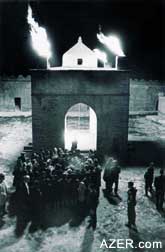|

Summer 2003 (11.2)
Pages
52-53
Atashgah
As Seen
by French Writer Alexander Dumas 150 years Ago
by Farid Alakbarli
  Left: Atashgah, the Fire Worshippers' temple
originally had four flames burning from the roof of the temple
as well as a main altar inside. Photo 1969. (Photo: Azerbaijan
National Photo Archives) Left: Atashgah, the Fire Worshippers' temple
originally had four flames burning from the roof of the temple
as well as a main altar inside. Photo 1969. (Photo: Azerbaijan
National Photo Archives)
In 1858, the great French
novelist Alexander Dumas ("the father") (1802-1870),
who is remembered for writing "The Count of Monte Cristo"
and "The Three Mousketeers," visited the Caucasus.
On his nine-month journey throughout the region, one of the places
that captured his imagination was Atashgah, the Fire Temple located
on the outskirts of Baku. Dumas wrote some of his impressions
about it in his book, "Travels in the Caucasus" which
was published the following year in Paris.
Dumas challenged his fellow Frenchmen not to delay in visiting
this site. He was right. Today, the Atashgah compound has been
converted into a museum and is no longer the living monument
that Dumas describes. The fire worshippers have long gone, and
the flames are no longer spontaneously burning in the domed cupola.
Today, the eternal flame is fed from gas channeled in through
pipes. Here is the scene as Dumas witnessed it approximately
150 years ago.
"After breakfast, we took
our seats in the phaeton (horse and carriage) that was waiting
for us at the front door and headed out to the famous Atashgah.
Baku's Atashgah is known throughout the entire World; that is,
with the exception of the French who rarely travel. This site
that is on fire both day and night is situated 26 kilometers
distance from Baku. The eternal flames emanate from the black
and crude oil beneath the ground."
"It took us two hours to arrive at Atashgah. During the
first part of our journey, we went along the seashore. At Atashgah,
we climbed to the top of a hill from where, we could view all
of Atashgah with its fires. Just imagine an area of 4.5 square
kilometers!
"Great tongues of flame soared in the air from the hundreds
of tiny round fissures in the ground. The wind would scatter
the flames, curve them and then straighten them, spreading them
along the ground and then lifting them up to heavens again. But
it was impossible for the wind to extinguish them.
  Left: Atashgah, the Fire Worshippers temple,
prior to 1940. Note the oil wells in close proximity outside
the Atashgah compound. The site has been converted into a museum
and may be visited duringthe daytime. Atashgah is located outside
of Baku at Surakhani, in the direction of the airport. (Photo:
Azerbaijan National Photo Archives) Left: Atashgah, the Fire Worshippers temple,
prior to 1940. Note the oil wells in close proximity outside
the Atashgah compound. The site has been converted into a museum
and may be visited duringthe daytime. Atashgah is located outside
of Baku at Surakhani, in the direction of the airport. (Photo:
Azerbaijan National Photo Archives)
There was a big quadrangular
building which also was lit by a fire. Reflections of the flames
danced on the walls of the building, making it seem like the
building itself was moving.
"There was a white washed temple, surrounded by little ovens
again filled with tongues of flame. The gas burned with such
loud noise that each of these little ovens sounded like a big
furnace. On the roof, great tongues of flame were emitted from
each of the four corners of the big cupola. But these flames
were weaker than the fire nearby the Eastern entrance of the
temple.
"We approached the compound through a single gate situated
in the East. Then a spectacular and very beautiful view opened
up before our very eyes. It is said that this place is usually
only illuminated like this on holidays. It turned out that M.
Pigulevski (the Russian authority in Baku) had notified the people
at Atashgah about our arrival. These fire-worshipers, who have
experienced repression for more than 2,000 years, obeyed his
order and prepared everything to the best of their ability.
"My compatriots who would like to see these fire worshippers
better hurry. The only worshippers left are an old man and two
others around 30-35 years old. One of young men had just arrived
from India only six months earlier. That is, before him there
were only two worshipers left at Atashgah.
"We entered through a door which was completely enveloped
in flames. In the middle of a big, quadrangular court, there
was a domed building with an altar in it. In the middle of the
altar, an eternal flame was burning. The gas flames were also
emitted of all four corners of the dome. It was necessary to
climb five or six stairs to approach the altar.
Approximately 20 cells were situated along the external wall
which opened up to the courtyard. These cells were built for
disciples who were preparing themselves to become Zoroastrians.
In one cell, there was a niche displaying two idols.
"One of the worshipers robed himself in the priest's vesture.
Another one, who was completely naked, put on something like
shirt and the worship rituals began.
"During the ceremony, the priest sang, altering his voice
in a most unusual manner. He also performed a song which consisted
of four or five chromatic notes that ranged between "sol"
and "mi", and in which the name of Brahma (an Indian
god) was frequently mentioned. Sometimes, the priest prostrated
himself face down on the ground.
Another of the fire-worshippers beat upon the porcelain plates
which he was holding in his hands producing a high and ringing
noise. After the worship ceremony ended, the priest presented
to each of us a bit of sugar candy. In turn, each of us gave
him one ruble.
Dumas ended his account by saying, "We visited the Mt. Visuvius
of Baku, The Atashgah is greater than the Mt. Visuvius volcano
of Naples because it burns eternally. Then we returned to Baku".
Back to Index
AI 11.2 (Summer 2003)
AI Home
| Search | Magazine
Choice
| Topics
| AI Store | Contact us
Other Web sites
created by Azerbaijan International
AZgallery.org | AZERI.org | HAJIBEYOV.com
|


